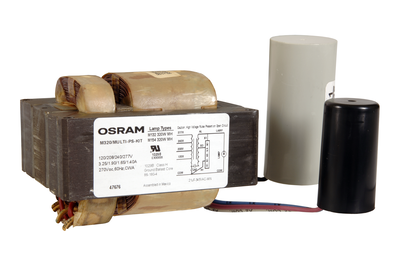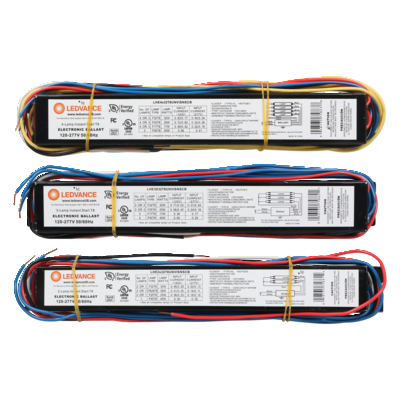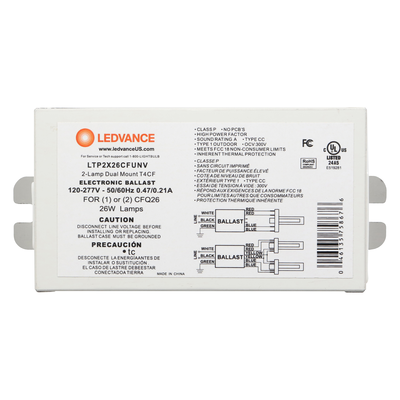Ballasts play a crucial role in the functioning of fluorescent lights, providing the necessary conditions for lamps to ignite and operate effectively. Understanding the different types of
ballasts for fluorescent light and their maintenance requirements is essential for ensuring optimal lighting performance and longevity. In this article, we delve into the workings of ballasts, explore their various types, and discuss maintenance tips. Now read on!
What is Ballast and How Does it Work?
A ballast is a device that is used with lamps to provide the circuit conditions needed for them to turn on and run. It communicates with the lighting fixture in order to manage, regulate, and, in the end, steady the lamp's light output. Ballasts are necessary for the effective operation of all HID and fluorescent lighting. The most seen light ballast in the market is Magnetic Ballast and Electronic Ballast.
How Many Kinds of Light Ballast?
Magnetic Ballast:
Magnetic ballasts are divided into capacitive ballasts and inductive ballasts. Capacitive ballasts use capacitors to regulate the current and one of the advantages is that they are not dependent on the line voltage to power the UV lamps. Small variations in power quality are also less likely to cause ballast failure. However, one disadvantage of capacitive ballasts is the potential for faster aging of the electrodes in UV lamps due to more electrode sputtering.
Magnetic ballasts use an inductor to control current by combining voltage and lamp properties. Magnetic ballasts' UV lamp electrodes last longer because less electrode sputtering occurs. Moreover, magnetic ballasts have a more stable current output and higher resolution and control capabilities. But they are less efficient, more expensive, heavier, and take up more space than capacitive ballasts.

Electronic Ballast: An electronic ballast has several components which work as a switching power supply. Compared to magnetic ballasts, electronic ballasts can send up to 50,000 pulses per second of current to the lamp. The amount of current supplied to the lamp varies under different conditions. For example, when the lamp is cold, the ballast provides longer, more frequent pulses of current to the lamp. As the lamp warms up and reaches normal operating conditions, the pulses become shorter and less frequent. Electronic ballasts are more efficient and compact in size and weight. But disadvantages are also obvious, power supply fluctuations may cause failure, although this can be offset by adding snubber capacitors. Also, the operation of the ballast generates heat, and too much heat might damage components and interrupt the flow of electricity to the lamp.

Proper Maintenance of Ballast for Fluorescent Lights
Proper maintenance of fluorescent lamp ballasts can maximize their performance and prolong their service life, thereby improving lighting quality and reducing maintenance costs
Regularly inspect and clean: Periodically inspect the ballast for damage or signs of wear. Over time, dust and grime can build up on the ballast, reducing its performance.
Avoid Overheating: Fluorescent ballasts generate heat when in use. Make sure they are well-ventilated to keep them cool and prevent overheating.
Avoid Overloading: Overloading ballasts with too many lamps can cause them to fail prematurely. Follow the manufacturer's recommendations for maximum lamps per ballast.
Wired correctly and safe with electricity: Check the ballast's wiring connections to make sure they're properly connected and secured, and make sure it's powered safely to avoid short circuits.
LEDVANCE Ballast Recommendation
Introducing the T4 Compact Fluorescent Programmed Rapid Start Ballast from LEDVANCE – your ideal lighting solution.
We take pride in presenting our own line of electronic ballasts, now featuring the
Dual Entry CFL ballast capable of operating DULUX D/E and T/E lamps. This ballast model comes with color-coded connectors on the side and bottom, offering mounting flexibility for various setups. Meeting industry standards, our ballast is competitively priced. For more information on potential TLED pairing, check out our Ballast compatibility list.
Whether for residential or commercial spaces, LEDVANCE's T4 Compact Fluorescent Programmed Rapid Start Ballast delivers stable and efficient lighting solutions. Experience the quality and performance of LEDVANCE today!

Conclusion
In conclusion, ballasts are integral components of fluorescent lighting systems, regulating lamp operation and ensuring consistent performance. By understanding the differences between magnetic and electronic ballasts and following proper maintenance practices, users can maximize the lifespan and efficiency of their lighting setups. LEDVANCE's T4 Compact Fluorescent Programmed Rapid Start Ballast offers a reliable solution for those seeking quality and reliability in their lighting fixtures.



